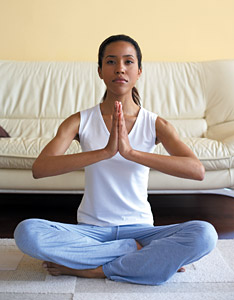Newton's law of inertia tells us that an object in motion stays in motion and that an object at rest tends to stay at rest. This very accurately describes the mind. In our 24/7 world, we are constantly processing.
Meditation is a somewhat loaded word. For some it conjures '60s era hippies all sitting lotus-style in a patchouli filed room. For others, it seems nearly impossible with statements ringing through the head like: "There's no way I can meditate," "I could never sit still that long," "My mind moves too much to be able to meditate," "I don't have time." The beauty of meditation is that there are many flavors. A little bit of education could be all that's needed to move past some of these hurdles to experience all that mediation has to offer.
So, first let's talk about what meditation is.
At the most basic level, meditation is a practice in mindfulness. The goal is not necessarily to erase all thoughts from the mind, but instead to quiet or still the mind. The mind thinks, there is no getting away from that. The idea is to take the mind's eye from the blurring thoughts of the day or a project that needs to be done and turn it on something else. What else, you ask? Well this largely depends on what kind of meditation you practice. In some cases it may be a visual stimulus like a candle flame. In others it may be more of a thought form like a silently floating mantra. Or perhaps it's auditory, with either a guided experience or just the sounds of nature happening around you. In yet still other forms, movement is the central focus. And of course, there are other sensory practices that may use the senses of smell or taste to help elevate you from the daily grind.
Perhaps this now becomes even more complicated...what kind of meditation should I practice? Well, that's the easy part. You can try all of them to see what fits you best. While there are some types of meditation that encourage things to be done in a certain way, ultimately there is no hard and fast rule. You could do a different practice everyday if that what feels good. The best practice is one that you will do regularly. So, my advice would be to figure out what will keep you coming back. After all, there are many benefits to meditating. However, you only experience the full extent of those benefits if you practice it regularly. Simply knowing how to meditate is not enough to reap the rewards. Some of the cited benefits of meditation include: less overall stress and quicker recovery from stress, more energy, clarity and better performance; less reactive behavior; better sleep; lower blood pressure; enhanced creativity, memory and IQ; increased intuition; overall better health and feelings of peace and wellbeing.
The second most common question is in regard to some of the how of meditation such as position and length of time. Again, in some cases, this will be somewhat driven by the type of meditation you do.
 For example, in a movement form of meditation such as walking, yoga or tai qi your position is dictated by what you will be doing. Another example in say a guided meditation is that the length of the meditation will be as long as the guided experience you select. However, if you are doing a visual, mantra or self-directed meditation, you are the boss.
For example, in a movement form of meditation such as walking, yoga or tai qi your position is dictated by what you will be doing. Another example in say a guided meditation is that the length of the meditation will be as long as the guided experience you select. However, if you are doing a visual, mantra or self-directed meditation, you are the boss.
Regarding length, a few minutes may do the trick or after doing meditation for a period of time a few hours may be in order. (Reminder: working in your garden or walking through the woods can be a form of meditation with the intention of mindfulness.) My own practice consists mainly of a mantra or breath-based meditation of 20-30 minutes once or twice a day.
However, if I take my practice on the road and let nature be my muse, the time varies greatly depending on how I feel. The point is that this practice is for you, so make it your own. Some days you may be rushed for time or tempted to skip it; perhaps try just a few minutes to de-excite your body and mind. On other days, you will crave that stillness and will have to set a little timer to make sure you can get the rest of your day done.
Meditation is a gift. It is easy to learn, inexpensive and provides so many returns for time invested. In today's society, this is no longer practiced by the new-age societal fringe, but a practice that is recommended and practiced by even the most traditional medical doctors.
After doing a little investigation, you'll see that all types of people practice meditation and many more would benefit from it. Just remember, this is not about running from the problems and issues of the day or spending all hours of the day in a deep meditative bliss. It is about being able to function and thrive in today's fast paced society.
What you learn in your meditations will begin to work its way in to all aspects of your day. You will find in a short time that you're able to perform at higher level, less effected by the inevitable stress that life brings and do it all with a little more joy and happiness in your heart.
Kara Leskie is a student at Emperor's College of Traditional Oriental Medicine.



